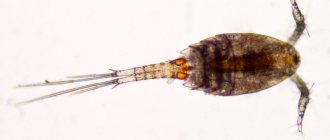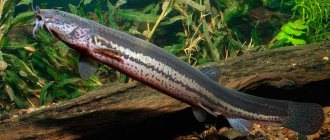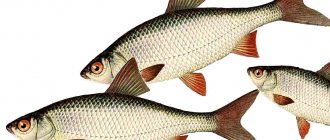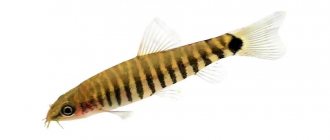Bloodworms for aquarium fish are a very nutritious and fairly versatile food, which is why they are widely used. Bloodworms contain 50-65% protein, 3-10% fat and up to 30% carbohydrates. Bloodworms are the red larvae of non-blood-sucking mosquitoes that are up to two centimeters long. Aquarists feed both large and small species of fish with bloodworms; finely chopped bloodworms can be given even to fry.
The nutritional value of bloodworms is also due to the large amount of hemoglobin contained in its blood, which is why the larvae have such a bright red color. Aquarium fish can be given live bloodworms, frozen, dried or freeze-dried. Live and frozen bloodworms have the greatest nutritional value. Currently, bloodworms can be bought at the poultry market and in pet stores, and preference should be given to the latter.
Frozen bloodworm
How to choose bloodworms for aquarium fish
Bloodworms are the most popular type of food. This name is given to mosquito larvae. In markets where there is an aquarium department, you can see bright red moving slides on the shelves. This is a bloodworm. Fresh larvae are mobile and bright red and have a specific odor.
They forage outside the city in ponds and small rivers throughout the year. But in the summer there is much more of it. Bloodworms contain a huge amount of vitamins and nutrients. Therefore, this food is given to small and large fish.
In order not to harm the fish, you should pay attention to the quality of the product. A good bloodworm is bright, mobile and does not have a rotten, unpleasant odor. The size of mosquito larvae should not exceed 1 cm. For the first time, buy a small amount of worms and give it to the fish. If everything goes well, then continue to buy food from the same seller.
Bloodworm larva food for aquarium fish
Bloodworms (Chironomus plumosus) are the larvae of the mosquito mosquito, considered the best food for aquarium fish. The bright red color of the worm-like larvae is due to the large amount of hemoglobin contained in their blood. The length of the larvae, depending on development conditions, ranges from 5 to 25 mm. You can buy bloodworms at a pet store, at a pet market, or catch them in local reservoirs.
Bloodworm habitat
Mosquito larvae live on the silted bottom of small bodies of water - in ponds, lakes, and in bays of slow-flowing rivers. Their food is organic remains, which they find on the surface of the silt, or burrowing into it to a shallow depth. The larvae hatch from tiny eggs that are laid in the water by adult mosquitoes in the summer.
At first they are gray in color, but after the first molt the color becomes characteristic of them - bright red. Gradually, the larvae create a tube from the secretions of the salivary glands and silt into which they hide. Only the head part of the bloodworm protrudes from the tube. Under favorable conditions, the larvae grow to 15-16 mm in two weeks and turn into pupae, which rise to the surface of the reservoir.
Sometimes you can find a large colony of bloodworms, catch a lot of larvae and store live fish food in the refrigerator for a long time. They are caught at air temperatures from 0 to 10°C, raking the upper part of the silt from the bottom of the reservoir. In this case, they use a bucket with a rope tied to it or a ladle with a long handle. The sludge is washed in a sieve lowered into water. You cannot use a net with a metal mesh - because of it, the larvae are injured and quickly die.
How to prepare bloodworms for fish
Bloodworms purchased or caught independently are washed under the tap and then kept for 3-5 days in water, which must be changed periodically. During this time, the intestines of the larvae will be cleansed, and only then can they be fed to the fish. But bloodworms cannot be stored in chlorinated tap water - mosquito larvae die due to chlorine. It is better to use settled or boiled water.
Before giving to fish, it is recommended to pre-disinfect the larvae in a weak solution of methylene blue or potassium permanganate , and also treat them with antibiotics (for example: trypaflavin and kanamycin kill the causative agents of tuberculosis). The intestines of bloodworms may contain dangerous pathogenic microflora. During disinfection, some of the drugs will still get into the tissues of the larvae, so some aquarists refuse to use chemicals and simply soak the food in kefir or bifidok.
How to store bloodworm food for fish
Let's move on to a very important question: how to store fish food. First of all, you need to remember that the bloodworm Chironomus plumosus turns into a twitching mosquito. They don't bite, but quickly scatter around the room. To prevent this from happening, store fresh larvae in the refrigerator (garage, cellar), at a temperature of 4-10°C:
- In a flat cuvette with a small amount of water (for 1 tablespoon of bloodworms, 0.5 liters of water)
- Wrapped in a damp rag or newspaper, and the layer of food should be approximately 10 mm thick in the rag and 5 mm in the newspaper, otherwise the larvae will suffocate without access to oxygen
- On a damp sponge, which is covered with gauze on top
- In potatoes (cut a large potato in half, then scrape out the inside, leaving the walls approximately 5 mm thick, place the larvae in the resulting depression, secure both halves of the potato with an elastic band)
- In a fabric bag placed in the toilet cistern
- Mixed with the tea, but you will have to tinker with separating the worms from the tea leaves during feeding
- Mix with chopped cabbage leaves (shelf life up to 20 days)
- In sand with water (washed fine sand is poured into a ditch with a layer of 1-2 cm, a portion of bloodworms is placed there - the living ones are quickly buried, the dead ones float up, after which they can be thrown out along with the water)
- In a thermos with ice cubes in damp gauze
- In a special blood bottle, slightly covered with water (you only have to change the water every day and wash the blood bottle with laundry soap once a week)
How to rinse bloodworm food for aquarium fish
Every day, in the evening and in the morning, the worms are washed, discarding the lethargic and dead ones (gray or whitish). Only the best food for fish is left - live, rich red in color. To wash bloodworms, use a special sieve - bloodworm . The bottom of the bloodworm should touch the surface of the water, then the live bloodworm will quickly move into the water, and dead bloodworms and dirt will remain on the mesh.
You can hasten the bloodworms with heat by heating the bloodworm with a lamp, but the main thing is that the temperature should not be high, otherwise the larvae can be dried out. For further washing, you can use a fine-mesh mesh - lower it into water, small worms will crawl into the water, and large ones will remain on the mesh.
Bloodworms can be stored using all of the above methods for one, maximum two weeks. The packaging needs to be wetted regularly (but it’s the packaging, not the worms!).
It is convenient to use a spray bottle. If you don’t have it, just wet your hand under the tap and shake off drops of water onto the packaging. If a putrid smell appears, it is better to throw away the entire portion (even if there are live worms left in it, they are poisoned and are not suitable for food).
How to freeze bloodworm food for fish
Bloodworms can be quickly frozen to create homemade frozen fish food. When stored in a freezer at a temperature of minus 18°C or lower, the larvae will retain their taste and nutritional qualities and will not change shape or color. The disadvantage of this type of food is that the chitinous skin of the worms is thin; when damaged by ice crystals, it bursts and some of the “juice” gets into the water.
This is not dangerous for large aquariums and adult fish. But in small nursery aquariums, after each feeding, the water becomes highly oxidized (pH changes) and must be changed frequently, otherwise the juveniles may die. Before freezing, the worms are kept in a saline solution for 40-60 minutes (2 tablespoons of salt per 1.5 liters of water), washed thoroughly and placed in portioned cuvettes.
How to feed fish with bloodworms in an aquarium
Adult fish are fed whole bloodworms, not cut into small pieces. It is not recommended to throw bloodworms into the water - they quickly sink to the bottom of the aquarium and burrow into the ground, so fish feeding on the surface of the water and in the middle layers of the aquarium will remain hungry. It is better to give mosquito larvae in special lattice feeders.
Worms sprinkled on the bottom of a floating feeder are quickly eaten by fish. It is also important how much food to give the fish. The amount of bloodworms per feeding of the fish is determined depending on its size and the size of the larvae. Optimal: 1-5 pieces of bloodworms per fish.
Large worms can be cut into small pieces, but the nutritional value of such food will be lower than that of a whole bloodworm. They are cut with a thin blade on glass, a wooden or plastic board. The blood is allowed to drain, and the slurry of chopped larvae is dropped into the fish feeder.
Some aquarists advise feeding small fish with “estuary” bloodworms. This type of bloodworm lives in river mouths, where fresh water mixes with salty sea water. The larvae are small, less than 5 mm, carrot or light red in color. Sometimes industrial waste accumulates in estuaries, and feeding fish with larvae from such contaminated biotopes must be done with great care.
is considered the most environmentally friendly . In natural conditions, it comes in different sizes - large, medium and small. You can choose worms that are suitable in size for your aquarium fish and give it whole, without cutting it into pieces.
How to store bloodworms
Store mosquito larvae alive, dry and frozen. To keep them alive for several days, take a small box and place gauze on the bottom so that its ends hang outside the box. During storage, the gauze should be damp (not wet).
Place a thin layer of bloodworms on the gauze, and cover it with the ends of the gauze hanging from the box. Close the box loosely and place it on the refrigerator door. Rinse the live food in the net with tap water several times a day. With this storage method, the worms will not be alive for long.
The most convenient way to store bloodworms is freezing. To freeze, take a food bag and put live worms in it (the quantity depends on the size of the bag). Then carefully shape the bag into a briquette, doing this so that the larvae cannot crawl out of it. Then place the briquette in the freezer. After a few hours, the living larvae will become like a solid mass. With this storage, the food does not spoil for about 6 months. It is very practical to freeze in ice cube trays, then dividing the solid mass into portions will not be difficult.
Mosquito larvae can be dried. Take a baking dish, spread a thin layer of worms on it and place in a preheated oven for a few minutes. If you do not want to dry it, buy already dried food at the market. As you can see, there are many ways to store bloodworms.
Freezing bloodworms in ice trays
How to properly freeze live food
The easiest way is to freeze the coretra. For example, I do it this way: I keep the caught larvae in a net for 15 -20 minutes to allow the water to drain completely. When frozen, excess liquid will turn into ice and squeeze the contents of the larvae out, leaving only one shell of them. Such food is considered a waste and is eaten very poorly or not at all by the fish.
Next, I place the larvae in specially prepared plastic jars in a layer of 10-15 cm and place them in the freezer. You can make plastic jars from the cut off bottom of plastic bottles. It will be more difficult to freeze bloodworms, as well as copepods and cladocerans. For high-quality freezing, it is necessary that the water content in them is minimal.
For this purpose, the bloodworms and crustaceans must be dried well, kept for some time on any thick material and, in a semi-dry, dehydrated form, placed in plastic molds or jars and placed in the freezer. Before feeding the fish, frozen food must be thawed.
How to properly feed fish with bloodworms
Everything is clear with storage. But what is the correct way to feed fish with bloodworms? Mosquito larvae are nutritious, so you should not overfeed your pets with them. After all, bloodworms are to fish as salami is to people.
When feeding, follow these recommendations:
- If the fish have not eaten the entire portion of live larvae, then catch them before they turn into mosquitoes and start flying around the apartment.
- Uneaten remains of ice cream and dry food can spoil the water in your home pond in a short time.
- Feed the fish so that the food is eaten immediately, no more than 2 minutes.
- Before feeding, the required portion of frozen food is defrosted in a container with water, washed with running water and only then given to the fish.
- For small fish, bloodworms are crushed. But then blood appears. Even a small amount of blood turns the water cloudy.
Feeding aquarium fish and fry with bloodworms
Despite the high nutritional value of bloodworms and the presence of various vitamins, you should not feed your aquarium fish only with them. If the fish are fed heavily with bloodworms, they may become obese and, as a result, have problems with reproduction; also, heavy feeding with only bloodworms causes diseases of the gastrointestinal tract due to the fact that the larval shell is difficult to digest.
Never overfeed your fish with bloodworms and try to diversify their menu on different days, so that bloodworms in their diet make up no more than 60-80%, i.e. It is better to feed them with other food 1-2 days a week. When feeding fish with live bloodworms, use special floating cone bloodworm feeders with meshes. The live bloodworm will crawl out through the mesh, where it will be immediately eaten by the fish. The dead bloodworm will remain in the feeder and can be thrown out of the aquarium.
Specialized bloodworm feeder
The fry can be fed with bloodworms, after cutting the larvae into small pieces with a sharp blade. After feeding, all uneaten bloodworms must be removed from the water, as their blood can greatly spoil the water. When feeding chopped bloodworms, it is necessary to perform regular water changes in the aquarium.
How to defrost food correctly
Note: Remember that repeated freezing significantly reduces the quality of the feed! All prepared frozen food is never completely defrosted. When re-frozen, it not only loses its natural appearance, but also its nutritional value.
If you purchased a briquette of frozen food, you need to break off a small piece from it and place it in a net, hold it under the tap, washing it with cold running water until it is completely defrosted, and only then feed it to the fish.
If you have defrosted too much food, you need to place it in a separate container, store it in a cool place and feed it little by little to the fish. If the food is frozen in a plastic jar, you need to place the jar in a net and place it under a small stream of running water. As the required amount of defrosted food accumulates in the net, defrosting should be stopped and the jar of frozen food should be placed in the freezer.
This method of defrosting live food is good because it is thoroughly washed, and its defrosted amount can always be controlled. To ensure that the food is always eaten by the fish, it is necessary to add it in small portions using tweezers or a measuring spoon for hygienic reasons. Floating feeders for frozen food are not needed since the defrosted food does not spread over the surface, but falls to the bottom.











